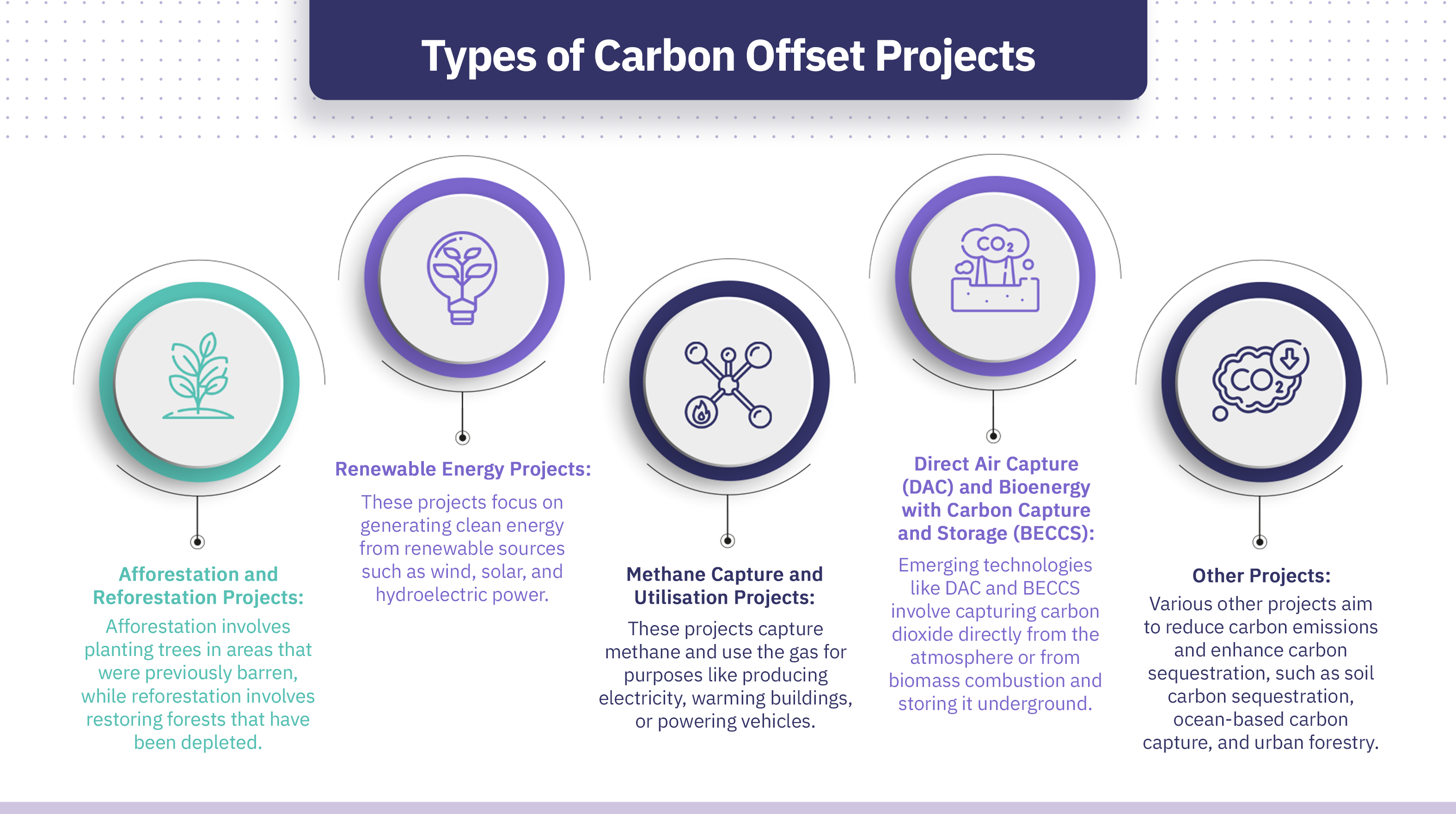The Role of Carbon Offsets in the Net-Zero Journey
Carbon offsets can be defined as a simple mechanism that businesses use to finance the reduction or avoidance of carbon dioxide from the environment, to compensate for unavoidable carbon emissions in their value chains. This is often done by investing in renewable energy or carbon sink projects. As a crucial component in combating climate change, carbon offsets can counterbalance a portion of a company’s greenhouse gas (GHG) emissions and bring them closer to achieving net zero.
Carbon offsetting for net zero may seem like a financial transaction for organisations or businesses, but the actions behind it usually involve a lot of groundwork. Numerous strategies, including projects for reforestation and afforestation, capturing and utilisation of methane emissions, and renewable energy initiatives, are used as different types of carbon offsets. These offsets, while not a replacement for direct emissions reduction, can help companies make tangible progress on their net zero journeys.
The Importance of Carbon Offsets in Achieving Net-Zero
Although there is no way to defeat the climate crisis without direct emission reduction strategies, companies often face some key limitations. Reducing GHG emissions at the source is a time and resource-intensive undertaking – financially challenging for smaller businesses. There are also economic, infrastructural, regulatory, and technological constraints that can make direct emission reduction challenging.
Carbon offsets can complement companies’ efforts for net zero. These offsets are a continuous effort towards climate mitigation, but they also serve as immediate action that companies can take while they work on emissions reduction.
Carbon offsets can also bridge the durational gap between short-term and long-term sustainability goals. While companies figure out how to reduce their Scope 1, 2, and 3 emissions, the immediate emission reduction they “offer” are a tangible first step in the fight against climate change. Simultaneously, carbon offsets can smoothen the transition to renewable energy sources, by providing a more cost-effective way for businesses to address unavoidable emissions. This can be especially beneficial for companies that find it challenging or financially burdensome to completely eliminate all their emissions through direct operational changes. Carbon offsets also allow companies to demonstrate progress toward their net zero goals, even if they have not yet begun reducing operational emissions. This can build their green credentials.

Types of Carbon Offset Programmes
- Afforestation and reforestation projects: By planting trees in deforested areas and new land, this type of carbon offset can absorb carbon dioxide from the atmosphere. Initiatives like reforestation or afforestation not only support biodiversity and ecosystem restoration but also offset carbon emissions. Evident by the Great Green Wall in Africa, the reforestation of parts of the Amazon rainforest, and many other such examples, reforestation projects are scalable and effective and improving biodiversity, but challenges like illegal deforestation diminish the effectiveness of such programmes.
- Renewable energy projects: Wind and solar power are just a few examples of renewable energy sources that play a substantial role in carbon offsetting. By investing in projects to build and set up windmills, solar panels, and water turbines, businesses can contribute to the overall reduction of direct carbon emissions. This reduces the dependence on fossil fuels and generates clean energy. The automotive industry, for example, is experiencing a radical shift where more and more electric vehicles are being developed. For instance, the US Environmental Protection Agency (EPA) has rolled out its most expansive vehicle emissions reduction plan thus far, requiring 13% annual average pollution cuts and a 56% reduction in projected fleet average emissions over 2026 requirements. The EPA is also proposing new stricter emissions standards for medium-duty and heavy-duty trucks through 2032. Sustainability-conscious consumers are also switching to using public transportation and renewable energy in their vehicles. For instance, in the United States, this is furthered by government incentives like the Clean Vehicle Credit for consumer electric vehicle (EV) purchases. This creates large financial incentives for building EV supply chains, which by building demand, encourages automotive companies to build economies of scale in EV production. As such, EV adoption is increasingly displacing the dependence on gasoline and diesel-powered vehicles.
- Methane capture and utilisation projects: Methane (CH4) is one of the most challenging GHG emissions to manage as it is 28 times more efficient at trapping radiation, and thus heat, within the earth’s atmosphere than carbon dioxide. Agricultural activities and waste management are among the major contributors to methane (CH4) emissions. However, methane can be captured from landfills, for example, and used to produce electricity, heat buildings, or power garbage trucks among other uses. Their capture and utilisation provides a pathway for carbon offset programmes – which can reduce the effects of climate change.
Future of Carbon Offsets
- Technological advancements in carbon offsetting: Emerging technologies like direct carbon/air capture (DCC/DAC), bioenergy with carbon capture and storage (BECCS), and other advanced carbon sequestration are shaping the future of carbon offsets. These technologies expand the scalability and effectiveness of carbon offset programmes. They offer a glimpse into a future of more capable carbon offset programmes.
- Market trends and evolving regulations: Be it consumers or investors, people are becoming more aware of the climate crisis and committing towards sustainability. Evolving regulations are also pushing businesses to integrate carbon offsets into their operations. Businesses that embrace both direct emission reduction and carbon offsets stand to gain a competitive advantage and avoid regulatory penalties.
- Emissions measurement and management: For companies to understand how much of their emissions they need to offset, they must invest in effective emissions management. End-to-end decarbonisation platforms such as Terrascope can provide granular visibility of operational emissions, providing specific insight into emissions hotspots. From there, Terrascope can identify decarbonisation levers, or emissions management strategies, that can assist companies with managing their carbon footprint. Based on the scale of unavoidable emissions, businesses can then identify how to choose the best carbon offsets to achieve net zero, specific to their own industry and priorities.
Conclusion
Carbon offsets are crucial towards the push to net zero. This is especially true as they can be configured based on business needs or unique sectoral circumstances. Although the elimination of GHG emissions is a priority, carbon offsets remain a critical tool in fighting climate change in the long run. The continued innovation in the carbon offset programmes and associated regulatory changes are sure to bring about a wave of positive change for the environment.
